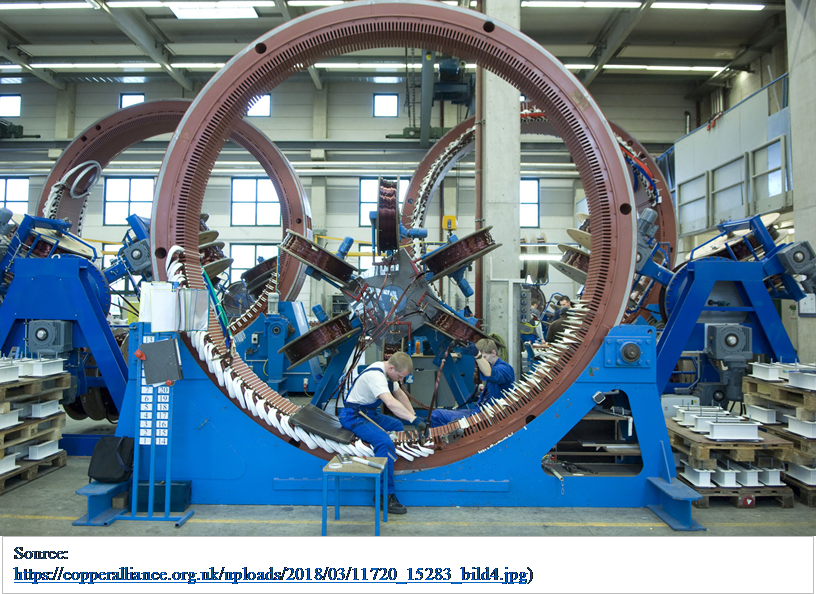Potentials of locally manufactured wound-field flux switching wind generator in South Africa
DOI:
https://doi.org/10.17159/2413-3051/2019/v30i2a6315Keywords:
Finite element analyses (FEA), technology localisation, prototype, South Africa, rare earth-free, wind power industry, wound-field flux switching machine (WF-FSM)Abstract
The China-based monopoly of high-energy permanent magnet materials used in modern wind generators impact the economic viability and local content value of most wind turbines installed in South Africa, especially large installations. It is possible to design with less expensive excitation technologies using locally-sourced wound-field electromagnets, which might promote local content. This study involves the optimum design performance comparison of the wound-field flux switching machine (WF-FSM) technology based on two variants – Design I and II (D-I and D-II) – the difference being in the arrangement of their DC wound-field coils. The machines are evaluated using finite element analyses (FEA) with optimum performance emphasised on design parameters such as torque density, efficiency and power factor. The selected design targets are meant to improve the performance to cost fidelity of the proposed wind generator variants. In 2D FEA, D-II can produce up to 18.8% higher torque density (kNm/m3) and 17.1% lesser loss per active volume (kW/m3) than D-I. In 3D FEA, the torque density of D-II remains higher at 10.6%, but its loss per active volume increases by 15% compared to D-I. The discrepancy observed in 2D and 3D FEA is due to an underestimation of the end-winding effects in D-II. The power factor of D-II is higher than D-I, both in 2D and 3D FEA, which may translate to lower kVA ratings and inverter costs. A higher total active mass ensues for the studied WF-FSMs than a conventional direct-drive PMSG, but avoiding rare earth PMs translate to significantly lower costs.
Downloads
References
REN21, Renewables 2018 global status report (Paris: REN21 Secretariat), 2018. Available: www.ren21.net/gsr.
Draft IRP-2018: Integrated Resource Plan – Department of Energy, Republic of South Africa, August 2018. Ac-cessed online on 2018/10/16 at: http://www.energy.gov.za/IRP/irp-update-draft-report2018/IRP-Update-2018-Draft-for-Comments.pdf
Goudarzi, N. and Zhu, W. D. 2013. A review on the development of wind turbine generators across the world. International Journal of Dynamics and Control 2013(1): 192–202. https://doi.org/10.1007/s40435-013-0016-y
Keysan, O. 2017. Future electrical generator technologies for offshore wind turbines, Wind Power, E&T IET Ser-vices, Aug 16, 2017. Accessed online on 2018/07/12 at: https://energyhub.theiet.org/users/60216-ozan-keysan/posts/19442-future-electrical-generator-technologies-for-offshore-wind-turbines
Pavel, C. C., Lacal-Arántegui, R., Marmier, A., Schüler, D., Tzimas, E., Buchert, M., Jenseit, W. and Blagoeva, D. 2017. Substitution strategies for reducing the use of rare earths in wind turbines. Resources Policy 52: 349-357. https://doi.org/10.1016/j.resourpol.2017.04.010
VENPOWER: http://www.venpower.de/index.html
Rauch, S. E. and Johnson, L. J. 1955. Design principles of flux–switching alternators. AIEE Transactions 74(3): 1261–1268. https://doi.org/10.1109/AIEEPAS.1955.4499226
Cheng, M., Hua, W., Zhang, J. and Zhao, W. 2011. Overview of stator–permanent magnet brushless machines. IEEE Transactions on Industrial Electronics 58(11): 5087–5101. https://doi.org/10.1109/TIE.2011.2123853
Potgieter, J. H. J. and Kamper, M. J. 2016. Double PM-rotor, toothed, toroidal-winding wind generator: A com-parison with conventional winding direct-drive PM wind generators over a wide power range. IEEE Transactions on Industry Applications 52(4): 2881-2891, 2016. https://doi.org/10.1109/TIA.2016.2536580
Kamper, M. J. 2009. Development and test results of South Africa’s first 300 kW permanent magnet direct drive grid connected wind generator system (discussion paper). 18th Southern African Universities Power Engineering Conference (SAUPEC), Stellenbosch, South Africa, 2009.
Akuru, U. B. and Kamper, M. J. 2018. Intriguing behavioural characteristics of rare-earth-free flux switching wind generators at small- and large-scale power levels. IEEE Transactions on Industry Applications 54(6): 5772-5782. https://doi.org/10.1109/TIA.2018.2848979
SEMFEM documentation: www0.sun.ac.za/semfem/index.html
VisualDOC user’s manual: Version 8.0, Vanderplaats Research & Development, Inc., Colorado Springs, CO, February 2017.
Vanderplaats, G. N. 2007. Multidiscipline design optimisation. Colorado Springs, USA: Vanderplaats Research & Development, Inc.
Akuru, U. B. and Kamper, M. J. 2018. Novel experimentation of a 10 kW geared medium-speed wound-field flux switching wind generator drive. 2018 IEEE Energy Conversion Congress and Exposition, Portland, Oregon, September 23-27, 2018: 6492-6498. https://doi.org/10.1109/ECCE.2018.8557762.

Downloads
Published
Issue
Section
License
Copyright (c) 2019 Udochukwu B. Akuru, Maarten J. Kamper

This work is licensed under a Creative Commons Attribution-ShareAlike 4.0 International License.



.png)